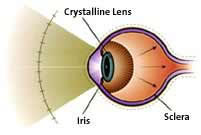Retinal Detachment |
Retinal detachment occurs when the retina's sensory and pigment layers separate. Because it can cause devastating damage to the vision if left untreated, retinal detachment is considered an ocular emergency that requires immediate medical attention and surgery. It is a problem that occurs most frequently in the middle-aged and elderly.
The first signs of retinal detachment are floaters and flashes of light, usually in the peripheral vision. The sudden appearance of spots or flashes can indicate a tear in the retina. A sudden increase in the number and size of floaters may also be a warning that the retina is tearing.
Wavy or water vision and a sudden loss of vision are also danger signs to look for. Blurred central vision indicates that retinal detachment is progressing and the result is significant, permanent vision loss unless it is repaired. Retinal detachment usually develops gradually, causing noticeable symptoms, but in some cases it occurs suddenly. This causes total vision loss in the affected eye. Total vision loss can also be caused by a retinal tear that bleeds into the vitreous.
|


|
Treatment
Early treatment can greatly improve the chance of restoring vision. There are a number of risk factors associated with retinal detachments including cataract surgery, diabetic retinopathy, family history of the disease, thinning of the retina and traumatic eye injuries.
Surgical treatment for retinal detachment depends on type, severity, and location of the detachment. Treatment risks include infection, bleeding, cataract development, and increased pressure inside the eye. However, without intervention, retinal detachment usually causes permanent partial vision loss or blindness.
Reattaching the retina can be done using laser photocoagulation, a method of sealing off leaking blood vessels. Destroying new blood vessel growth with a laser beam is another way to reattach the retina.
Cryotherapy is another method for reattaching the retina. It uses nitrous oxide to freeze the tissue behind the retinal tear, stimulating scar tissue formation that will seal the edges of the tear.
Pneumatic retinopexy is most effective for detachments that occur in the upper portion of the eye. The eye is numbed with local anesthesia and a small gas bubble is injected into the vitreous body. The bubble rises and presses against the retina, flattening it against the back wall of the eye. The gas bubble is slowly absorbed over the next few weeks and cryotherapy or laser is used to seal the retina into place.
|
|
|

